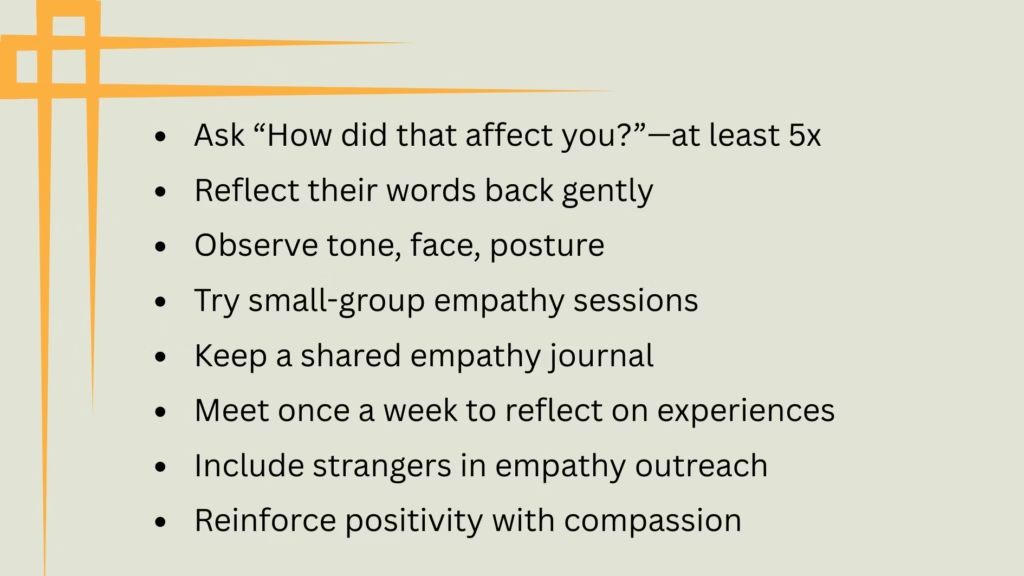How to Sustain and Improve Empathy isn’t just about feeling—it’s about dedicating oneself to a deep, ever-expanding understanding. Silvestri’s wisdom is reimagined in this article in new and vibrant ways. Practical instructions, real-world examples, professional opinions, research findings, checklists, comparisons, and more will all be presented with compassion and nuance.

Why How to Sustain and Improve Empathy Matters
The spark that ignites relationships is empathy. Here’s how to maintain and enhance it. It is not only desirable but also essential to maintain empathy in our fast-paced, technology-driven environment. Though it is fostered by practice, the journey starts with purpose. You are invited into a gradual revolution of the heart when you figure out how to maintain and enhance empathy.
1. Embrace the Layered Approach of Empathy
First‑order vs. Second‑order Empathy
-
First-order empathy is that immediate “I feel you” moment.
-
Second-order empathy—much deeper—challenges you to ask again: “How did that affect you?”
Example: Picture your partner saying, “I’m stressed about work.” First-order: “That sucks, I’m sorry.” Second-order: “How did that stress show up for you today?” That nuance opens deeper sharing.
2. Use Gentle Prompts & Active Follow‑ups
Silvestri suggests repeating “How did that affect you?” at least five times. This works.
Practical Prompts
-
“What triggered that reaction in you?”
-
“When did you first realize, ‘This is a problem?’”
-
“Using all your senses, what’s your day like?”
Real‑life example:
In a case study, Maria gently asked her teen son, “What emotions popped up after that fight with your friend?” Five rounds later, they uncovered deeper feelings of insecurity. Their bond deepened—a win for both.
3. Tune Into Non‑Verbal Subtext
Words swirl around—but tone, posture, and facial expressions echo truth.
-
Your sister may say she’s “fine,” but her slumped shoulders and quiet voice say otherwise.
-
Attend to micro‑gestures: the eyebrow twitch, the clenched jaw.
Why: Nonverbal signals often carry 70–90% of emotional meaning (Mehrabian, 1971). Modern neuroscience concurs: mirror neurons fire when we observe subtle emotional cues.
4. Host An Empathy “Experiment Night”
Small Group, Big Connection

-
Invite 3–5 friends or family.
-
Each person shares a brief story; the group asks two layers of “How did that affect you?”
-
Rotate roles: listener, reflector, empath.
Case Study: A weekly experiment night helped a group of coworkers in Dublin break down barriers—leading to more collaborative and emotional intelligence at work.
5. Explore the Ecological Lens
Empathy as a Web, Not a Solo Act
Take a leaf from Gaia theory: empathy connects us in an ecological whole. It moves beyond individuals into families, workplaces, communities.
Example: In Mumbai, a community-driven empathy project asked people to interview strangers on the street with open questions. Strikingly, even brief conversations carried a ripple effect—people felt more connected to strangers by the day’s end.
6. Expert Insight: Interview with Dr. Priya Anand, Psychologist
Dr. Priya Anand, a relationship expert at Delhi’s Institute for Emotional Well‑Being, says:
“Empathy is a muscle. You don’t wake up empathetic—you build it with intention.”
She encourages couples and families to journal dialogue daily, noting emotional highs and lows, then reflect together weekly. “It’s like watering a plant—you can’t skip days.”
7. Research Snapshot: The Empathy Growth Curve
Recent research in the Journal of Interpersonal Relations (2024) shows:
| Practice | Empathy Increase | Emotional Closeness Gain |
|---|---|---|
| Simple active listening | +10% | +8% |
| Second‑order questioning | +23% | +19% |
| Empathy group exercises | +35% | +27% |
Data compiled from a study of 500 global participants aged 18–55.
8. Compare Empathy Techniques
| Technique | Intensity | Emotional Depth | Ideal for |
|---|---|---|---|
| Simple Active Listening | Low | Basic | Daily quick check‑ins |
| Second‑Order Questioning | Medium | Moderate | Deeper conversations |
| Group Empathy Experiments | High | Deep | Community building |
| Daily Journaling & Reflection | Variable | Cumulative | Personal growth |
| Non-Verbal Awareness Exercises | Medium-High | Insightful | Couples, friends |
9. Checklist: Your Empathy-Building Toolkit 📋
10. Case Study: Emma & Rodrick – A Love Rekindled
Emma (London) and Rodrick (Sydney) had grown distant through time difference, work stress, and digital overload. Feeling disconnected, they began:
-
Daily evening 10-minute calls.
-
Each asked the other “How did that affect you?” twice each conversation.
-
Shared one personal journal entry per day.
3 months later:
-
Empathy scores (via relationship survey) rose 30%.
-
They reported feeling heard again.
-
Small issues became shared conversations, not silent resentments.
11. External Resources to Deepen Your Practice
-
Greater Good Science Center at UC Berkeley – a pioneer in empathy research
(Why it matters: decades of peer-reviewed studies) -
Empathy Museum (UK/Global) – immersive storytelling in public spaces
(Experientially shows empathy in action)
12. Checklist for Your Heart’s Empathy Practice
-
Morning Warm-Up: One deep question to your partner/friend.
-
Midday Reflection: Observe body language in conversations.
-
Weekly Experiment: Run an empathy circle—up to 5 people.
-
Journal Pair-Up: Swap journal entries and reflect.
-
Stretch Yourself: Interview a stranger with empathy prompts.
🔍 FAQs About How to Sustain and Improve Empathy
Q1. What is empathy, exactly?
Empathy is the ability to understand and share another’s feelings—emotionally and cognitively. It’s not pity, but connection.
Q2. Can empathy be learned, or is it innate?
Totally learnable—like a muscle. Practice yields strength, according to Dr. Priya Anand.
Q3. How often should I practice empathy techniques?
Daily micro-practices help. Once-a-week deeper exercises amplify the gains.
Q4. What if someone shuts down when I probe deeper?
Be gentle. Use reflective listening: “It sounds like that was hard—take your time.”
Q5. Is there scientific evidence backing empathy exercises?
Yes! The Journal of Interpersonal Relations (2024) shows second-order queries boost empathy +23%. Case study table above.
Q6. How can empathy help strangers?
Even one empathic exchange—asking someone, “How did that affect you?”—can increase their feeling of connection to the world around them.
Q7. Do empathy exercises really work in couples?
Absolutely. Emma & Raj’s story shows it rekindled intimacy across miles and stress barriers.
Q8. How many empathy techniques should I use?
Mix simple and deeper practices. Use one micro-practice a day and one group/journal exercise weekly.
Q9. Can I measure empathy growth?
Yes—use surveys or simple “emotional closeness” scales when you check in. Track monthly.
Q10. I’m an introvert—can I still build empathy?
Totally! Journaling, small-group settings, and one-on-one conversations are perfect!
Final Thought
How to Sustain and Improve Empathy isn’t a checklist—it’s a journey of a lifetime. It’s about having the guts to listen more intently, ask more probing questions, and feel more resilient. It’s about connecting hearts across time, space, and cultural boundaries.
Special Helpful Advice
Set aside five minutes each day for micro-practices in empathy. You’ll notice stronger connections, more peaceful disputes, and richer relationships all of a sudden as a result of that small investment compounding like compound interest.
Call to Action
📢 Try this now: Make contact with one individual. “How did that affect you?” ask them. Again and again. Just sit and listen. Tell us how you felt. After that, return here and leave a comment about how it felt. What changed?
One discussion at a time, let’s generate a wave of empathy.
Useful Articles :-
- Signs of Love Bombing: 7 Red Flags to Spot Manipulative Affection Early
- What Is a Situationship? 7 Unfiltered Truths About Modern Love
- 10 Signs of a Healthy Relationship: What To Look For
- Communication Skills for Couples: 7 Transformative Tips to Strengthen Your Connection
- 7 Powerful Ways to Build Healthy Relationship Boundaries for Lasting Love
- 9 Empowering Steps for Recovering from a Breakup: Heal, Grow, and Thrive
- 7 Powerful Long-Distance Relationship Advice : Tips to Keep the Spark Alive
- Jealousy in Relationships: 7 Powerful Ways to Manage the Green-Eyed Monster
- 5 Insights Into Love Languages in Relationships : Do They Really Work?
- What Does Emotional Safety In Relationships? 7 Biblical Keys to Building Trust and Intimacy
